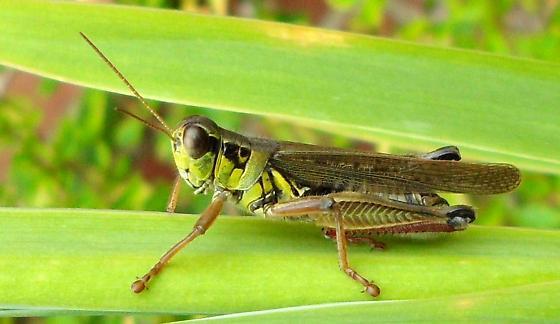Climate change may favor large plant eaters over small competitors

A new study shows that climate change that significantly decreases plant quality grants a competitive advantage to larger invertebrate herbivores, such as grasshoppers, who can convert the foliage to energy more efficiently than smaller herbivores. Credit: Andrew v. F. Block
Scientists have generally expected animals to get smaller as the planet warms, as research on the interactions in food webs has focused mainly on the effects of temperature. But the new study accounts for more climate variables, not just temperature, that could come into play, including atmospheric carbon dioxide levels and rainfall patterns.
The key factor appears to be plant quality.
In the study published in the journal American Naturalist, researchers developed a model based on food web interactions among plants, grasshoppers, and spiders exposed to multiple changing climate variables. The variables interact and influence plant nutritional quality, which in turn affects the herbivorous grasshoppers and the shared predator–the spiders.
The model shows that climate change that significantly decreases plant quality grants a competitive advantage to larger invertebrate herbivores, such as grasshoppers, ants and other insects, which are able to convert the foliage to energy more efficiently than smaller herbivores.
Temperature and moisture rather than atmospheric carbon dioxide appear to have the most influence.
The results suggest that climate change could predict increased body sizes in some cases.
“Global climate change involves not just a warming planet, but also increased atmospheric CO2 concentrations and changes in rainfall,” said lead author Lauren Smith-Ramesh, a postdoctoral fellow at NIMBioS. “All these factors should be taken into account when making predictions about how animal size will respond.”
###
The study's authors do not claim that the effect will be universal, noting that plant responses to climate change can be highly variable and context dependent, which in turn influences herbivore growth and development.
Citation: Smith-Ramesh LM, Rosenblatt AE, Schmitz OJ. 2018. Multivariate climate change can favor large herbivore body size in food webs. American Naturalist. http://dx.
The National Institute for Mathematical and Biological Synthesis is an NSF-supported center that brings together researchers from around the world to collaborate across disciplinary boundaries to investigate solutions to basic and applied problems in the life sciences.
CONTACT:
atherine Crawley
NIMBioS
1-865-974-9350
ccrawley@nimbios.org
Lauren Smith-Ramesh
NIMBioS
1-865-974-4980
lsmithramesh@nimbios.org
Media Contact
All latest news from the category: Life Sciences and Chemistry
Articles and reports from the Life Sciences and chemistry area deal with applied and basic research into modern biology, chemistry and human medicine.
Valuable information can be found on a range of life sciences fields including bacteriology, biochemistry, bionics, bioinformatics, biophysics, biotechnology, genetics, geobotany, human biology, marine biology, microbiology, molecular biology, cellular biology, zoology, bioinorganic chemistry, microchemistry and environmental chemistry.
Newest articles

A ‘language’ for ML models to predict nanopore properties
A large number of 2D materials like graphene can have nanopores – small holes formed by missing atoms through which foreign substances can pass. The properties of these nanopores dictate many…

Clinically validated, wearable ultrasound patch
… for continuous blood pressure monitoring. A team of researchers at the University of California San Diego has developed a new and improved wearable ultrasound patch for continuous and noninvasive…

A new puzzle piece for string theory research
Dr. Ksenia Fedosova from the Cluster of Excellence Mathematics Münster, along with an international research team, has proven a conjecture in string theory that physicists had proposed regarding certain equations….



